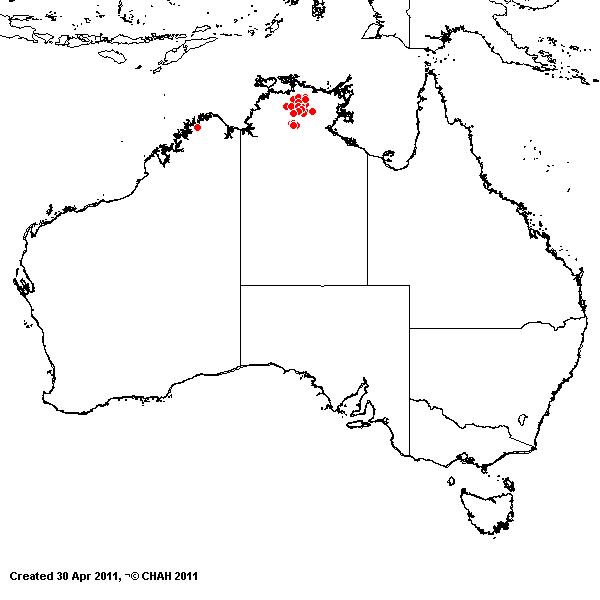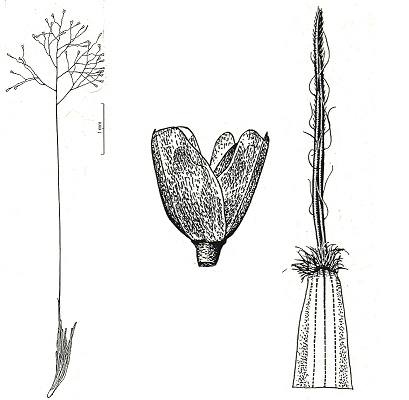Micraira tenuis M. Lazarides. Brunonia 2: 81 (1979).
Classification. (GPWG 2001) : Subfamily Micrairoideae. Micraireae.
Type of Basionym or Protologue Information: Australia: Northern Territory: Darwin & Gulf Distr.: 2–3 mi N of El Sharana Mine, 25 Jan 1973, Martensz & Schodde AE 595 (HT: CANB; IT: BRI, DNA, K, NT).
Key references (books and floras): [2002] D.Sharp & B.K.Simon, AusGrass, Grasses of Australia.
Illustrations: [2005] K.Mallet (ed.), Flora of Australia 44B: Poaceae 3 (fig. 21A-C).
Habit. Perennial. Culms prostrate, stature slender to delicate, 4–10 cm tall, 0.3 mm diam. Leaves cauline. Leaf-sheaths smooth or scaberulous. Ligule a fringed membrane, a ciliate membrane, 0.5–1.3 mm long. Leaf-blades linear or lanceolate or elliptic, 6–20 cm long, 0.3 mm wide. Leaf-blade surface scabrous, indumented.
Inflorescence. Inflorescence compound, a panicle. Panicle ovate, 2–3 cm long, 2–4 cm wide.
Spikelets. Spikelets pedicelled. Fertile spikelets 2-flowered, both fertile, comprising 2 fertile floret(s), without rachilla extension, oblong, laterally compressed, 0.75–1 mm long.
Glumes. Glumes similar, firmer than fertile lemma. Lower glume oblong or ovate, membranous, keeled, 1-keeled, 1(–3) -nerved. Lower glume apex muticous or mucronate. Upper glume oblong or ovate, 0.75–1 mm long, membranous, keeled, 1-keeled, 1(–3) -nerved. Upper glume apex muticous or mucronate.
Florets. Fertile lemma 0.8 mm long, keeled, 1 -nerved. Lemma apex muticous. Palea 2 -nerved. Palea apex divided to base. Lodicules absent or vestigial. Anthers 2. Grain 0.3–0.5 mm long.
Continental Distribution: Australasia.
Australian Distribution: Northern Territory.
Northern Territory: Darwin & Gulf.
Notes. The extremely thin culms and leaves, 1-nerved blades and delicate often prominently exserted panicles are diagnostic features of this species. The 1-nerved blade, comprising one unusually broad nerve and small margins much narrower than the nerve itself, is a rare feature occurring also only in M. inserta.
Occurs in a relatively wide area comprising the southern part of the Arnhem Land Plateau and nearby areas to the south; grows in small clumps or dense mats on shallow soils in crevices, seepage, depressions and similar seasonally moist habitats on plateaux and slopes of sandstone and coarse conglomerate, often in association with Triodia spp. and other Micraira spp. Flowers-fruits January to March, July.




